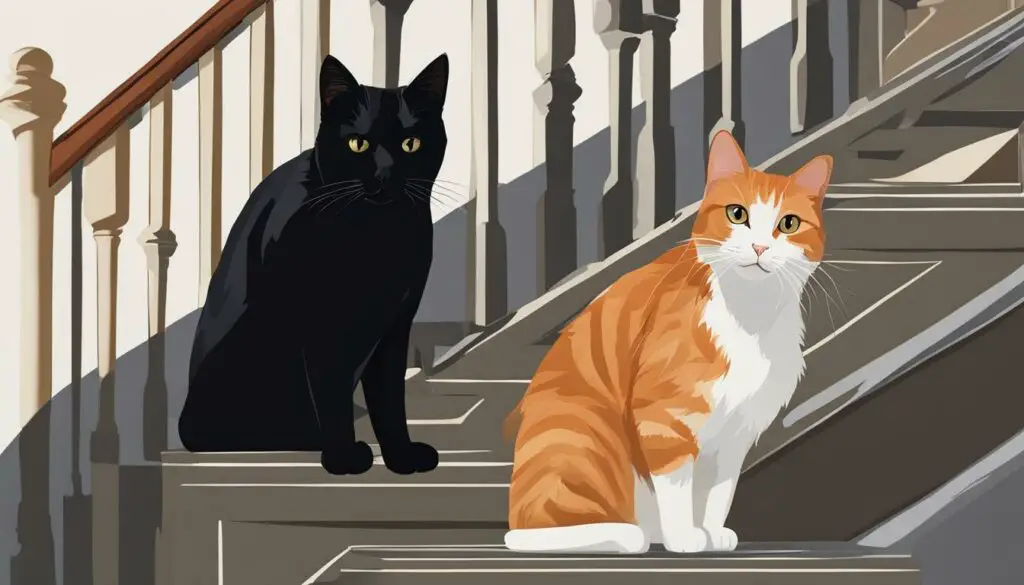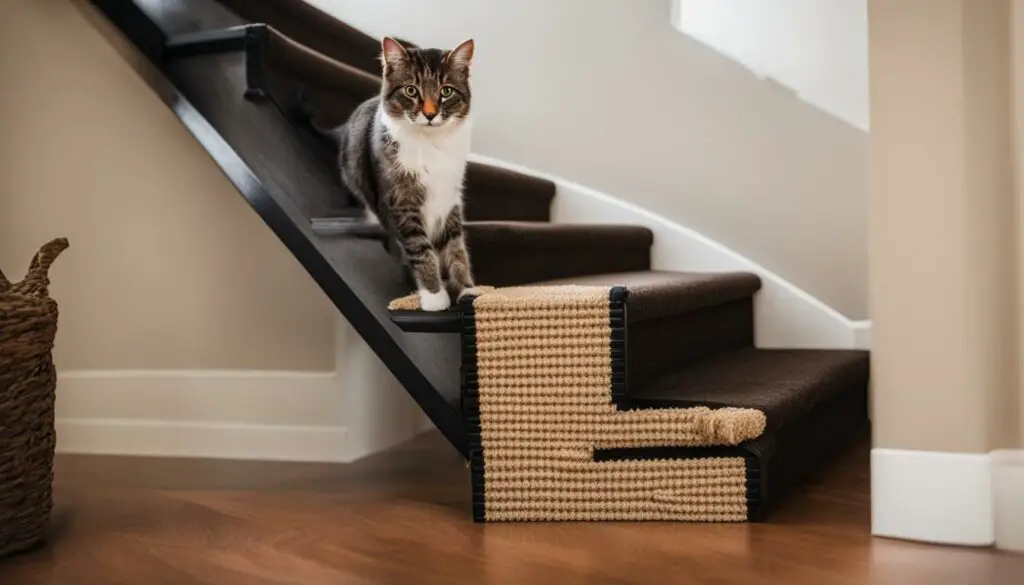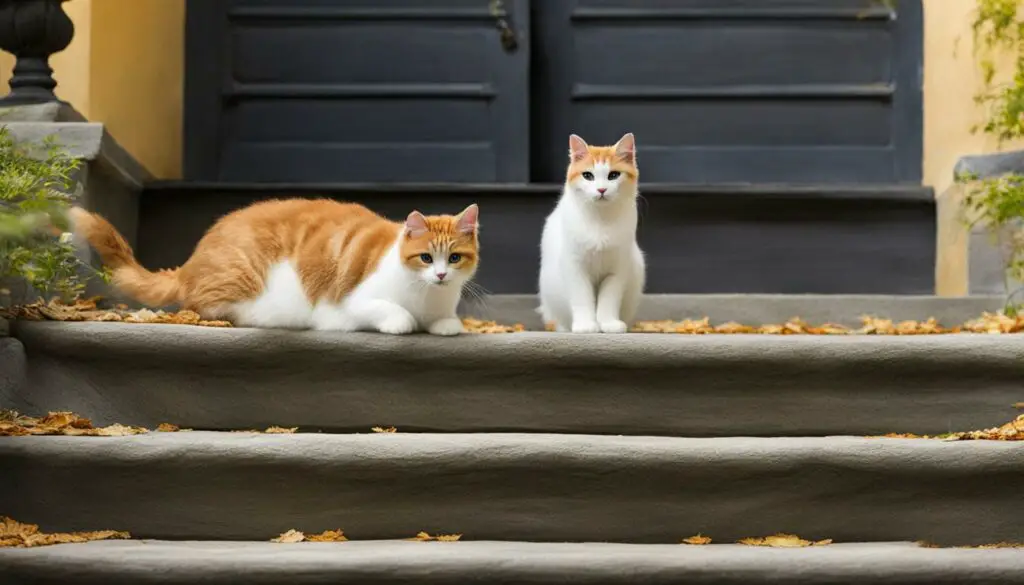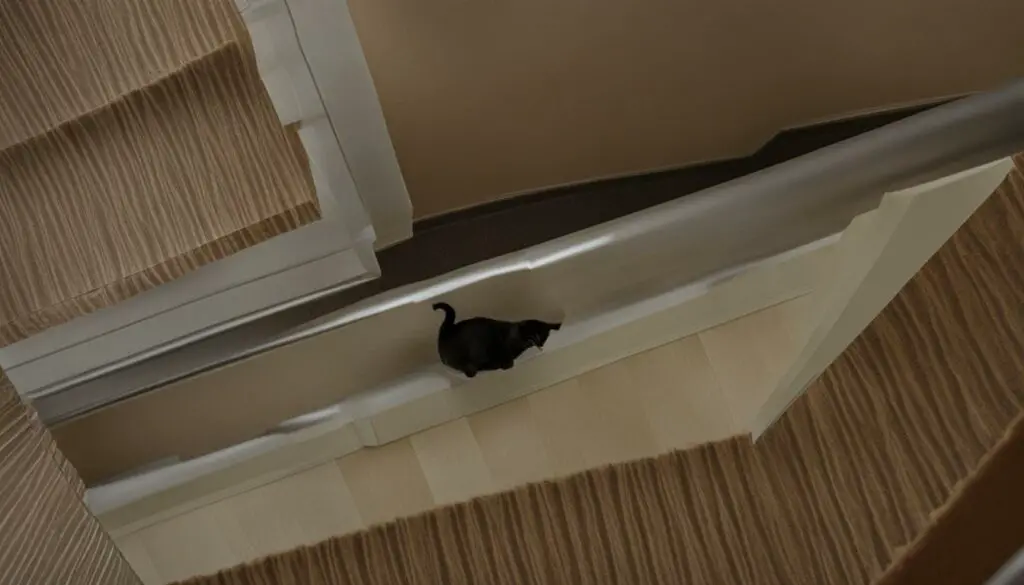Hello, I’m here to share some effective methods for keeping cats from going upstairs in your home. Cats are wonderful pets, but it’s understandable that you may want to limit their access to certain areas, like the upper floor. Don’t worry, there are several strategies you can use to create a cat-free zone upstairs without causing any stress or harm to your furry friend.
First, let’s explore why cats like going upstairs. Cats are natural climbers and explorers. They enjoy the vantage point that stairs provide, allowing them to survey their surroundings and seek comfort in high places. Understanding their behavior will help us find effective ways to discourage them from accessing the upper floor.
Now, let’s dive into some temporary solutions to keep cats from going upstairs. These quick fixes include using baby gates, spraying cat repellent on the stairs, placing double-sided tape, or using aluminum foil to create an uncomfortable surface. While these methods may work in the short term, they may not provide a permanent solution.
Creating a cat-friendly downstairs area is another effective approach. By providing toys, cozy beds, and engaging activities on the lower level, you can make it more appealing for your cat to stay downstairs and reduce their interest in exploring the stairs.
Motion detectors and cat repellent sprays can also be used as deterrents. Motion detectors can startle cats with noise or water spray, while repellent sprays with scents like citrus or peppermint can make stairs less inviting. Sticky double-sided tape and aluminum foil can create uncomfortable surfaces that cats want to avoid.
If these methods don’t work, physical barriers like baby gates or homemade structures can be used to block access to the upper floor. Additionally, with patience and positive reinforcement, you can train your cat to stay downstairs by teaching them basic commands like “sit” and “stay.
If you’ve tried everything and your cat is still determined to go upstairs, there may be underlying issues that need to be addressed. It’s important to assess why your cat is seeking the upper floor and address any behavioral or health concerns.
Remember, if all else fails, don’t hesitate to seek professional help from a veterinarian or cat behaviorist. They can provide expert advice tailored to your cat’s specific needs.
Now that you have an overview of effective methods to keep cats from going upstairs, let’s move on to the key takeaways.
Key Takeaways:
- Use a combination of deterrents, training techniques, and physical barriers to keep cats from going upstairs.
- Understand why cats like going upstairs to find effective strategies to discourage them.
- Temporary solutions include baby gates, cat repellent sprays, sticky tape, and aluminum foil.
- Create a cat-friendly downstairs area with toys, beds, and engaging activities.
- Motion detectors and cat repellent sprays can be effective deterrents.
Why Do Cats Like Going Upstairs?
Cats have a natural instinct to climb and explore their surroundings, which is why they are often drawn to going upstairs. There are several reasons why cats enjoy going upstairs and seek out high places, such as stairs. Firstly, cats have a strong prey drive and are always on the lookout for potential threats or prey. By perching themselves on the stairs, they have a vantage point that allows them to observe their surroundings and keep an eye out for any movement. This behavior is rooted in their wild instincts and is a way for them to feel safe and secure.
Secondly, cats seek out elevated areas for comfort and privacy. By going upstairs, they can find a secluded spot where they can relax and rest without being disturbed by other pets or humans. Cats are also known to seek out high places when they are feeling stressed or anxious. Being in an elevated position gives them a sense of security and control, allowing them to retreat from any potential threats or sources of stress in their environment.
Overall, cats enjoy going upstairs because it satisfies their instincts for exploration, hunting, and seeking high vantage points. Understanding these reasons is crucial in finding effective strategies to discourage them from accessing the upper floor. By addressing their need for a safe and elevated space, providing alternative options such as cat trees or shelves, and creating a cat-friendly environment on the lower level, you can help redirect their behavior and keep them content without the need to go upstairs.

Table: Reasons Why Cats Like Going Upstairs
| Reasons | Explanation |
|---|---|
| Instinctual behavior | Cats have a natural instinct to climb and explore their surroundings, and stairs provide an opportunity for them to do so. |
| Vantage point | Cats enjoy the elevated view that stairs provide, allowing them to observe their surroundings. |
| Comfort and privacy | Cats seek out high places for relaxation and privacy, away from other pets or humans. |
| Security and control | Being in an elevated position gives cats a sense of security and control, allowing them to avoid potential threats or sources of stress. |
Temporary Solutions to Keep Cats from Going Upstairs
When it comes to keeping cats from going upstairs, there are some temporary methods you can try that may provide quick fixes and simple deterrents. These solutions can help discourage your feline friend from accessing the upper floor without causing harm or stress.
One option is to use baby gates at the top of the staircase to block your cat’s access. Baby gates are easy to install and can be an effective physical barrier. Another temporary solution is to spray cat repellent on the stairs. The unpleasant scent of the repellent can make the stairs less appealing to cats, deterring them from climbing up.
Another technique is to place double-sided tape on the stairs. Cats dislike the sticky feeling on their paws and will try to avoid it. Additionally, you can try using aluminum foil on the stairs. The crinkling sound and unusual surface can be uncomfortable for cats, making them less likely to climb up.
While these temporary solutions can be effective in the short term, it’s important to address the underlying reasons why your cat wants to go upstairs. By creating a cat-friendly downstairs area and implementing long-term training techniques, you can help create a more permanent solution to keep your cat from going upstairs.

| Temporary Solutions | Effectiveness | Notes |
|---|---|---|
| Baby Gates | ⭐⭐⭐ | An effective physical barrier, but some cats may learn to jump over them. |
| Cat Repellent Spray | ⭐⭐ | Spray needs to be reapplied regularly to maintain effectiveness. |
| Double-Sided Tape | ⭐⭐⭐ | Cats dislike the sticky texture, but tape may need to be replaced frequently. |
| Aluminum Foil | ⭐⭐ | Some cats may get used to the foil over time. |
Creating a Cat-Friendly Downstairs Area
When it comes to keeping cats from going upstairs, one effective approach is to make the downstairs area a cat paradise. By providing an enticing environment filled with toys, beds, and other forms of stimulation, you can keep your cat occupied and content on the lower level.
Start by selecting a variety of toys that cater to your cat’s interests and preferences. Some cats enjoy interactive toys, such as puzzle feeders or treat-dispensing toys, while others may prefer toys they can chase or bat around. Experiment with different types of toys to see what captures your cat’s attention the most.
In addition to toys, create cozy sleeping areas for your cat on the ground floor. Consider placing comfortable beds or blankets in quiet corners or near windows, where your cat can relax and observe their surroundings. Providing multiple sleeping options can help ensure your cat always has a cozy spot to rest.
Remember to regularly rotate and refresh your cat’s toys and bedding to prevent boredom and keep their environment engaging.
By making the downstairs area a cat-friendly haven filled with toys and comfortable sleeping spots, you can make it more appealing for your cat to stay on the lower level. This approach not only keeps your cat from going upstairs but also provides them with an enriched environment that promotes their well-being and happiness.

Making Downstairs More Appealing
If your cat seems uninterested in the downstairs area, you can take additional steps to make it more appealing. Consider installing window perches or shelves near sunny windows, allowing your cat to enjoy a vantage point with a view. Cats are naturally drawn to high places, and these elevated spots can provide them with a sense of security and entertainment.
You can also incorporate vertical spaces in the form of cat trees or wall-mounted shelves. These structures give your cat opportunities to climb, scratch, and explore, which can further keep them engaged and deter them from venturing upstairs.
Lastly, ensure that your cat has access to food, water, and a clean litter box on the lower level. Cats are more likely to stay where their basic needs are met, so make sure these essentials are easily accessible to them downstairs.
Remember, creating a cat-friendly downstairs area is not only about deterring your cat from going upstairs but also about providing them with a stimulating and comfortable environment:
A cat-friendly downstairs area not only keeps your furry friend entertained and happy but also helps maintain a harmonious living space for both you and your cat.” – Cat Lover Magazine
Motion Detectors as a Deterrent
When it comes to keeping cats from going upstairs, motion detectors can be a clever and effective solution. These devices are designed to sense movement and can be strategically placed near the stairs to deter cats from climbing up. Motion detectors with noise-making capabilities can startle cats when they sense their presence, creating a deterrent effect. Alternatively, there are motion detectors that can be programmed to spray water when activated, offering an additional element of surprise for cats. These sudden and unexpected responses can effectively scare cats away from the stairs, discouraging them from accessing the upper floor.
Motion detectors for cat deterrence are widely available and can be easily purchased from hardware stores or online retailers. They are typically easy to set up and can be adjusted to suit the specific needs of your home. Whether you choose noise-making or water-spraying motion detectors, it’s important to ensure that the devices are safe for use around cats and won’t cause them harm or distress. By incorporating motion detectors into your cat deterrent strategy, you can create an environment that discourages cats from going upstairs, without causing them any harm.
Using motion detectors as a deterrent can be an effective and humane way to keep cats from going upstairs. These devices provide a sudden and unexpected response that startles cats, making them think twice about climbing the stairs. With noise-making or water-spraying capabilities, motion detectors offer a versatile and customizable solution for cat owners seeking to create a cat-free zone on the upper floor.
Incorporating motion detectors into your cat deterrent strategy can be a valuable tool in maintaining a harmonious living environment for both you and your feline companion. By leveraging the power of technology, you can successfully discourage cats from accessing the upper floor and ensure that they remain happy and safe on the lower level of your home.

Table: Comparison of Motion Detectors for Cat Deterrence
| Feature | Noise-Making Motion Detectors | Water-Spraying Motion Detectors |
|---|---|---|
| Functionality | Produce a loud noise when activated | Spray water when activated |
| Effectiveness | Startles cats with a sudden noise, encouraging them to stay away from the stairs | Surprises cats with a spray of water, creating a strong deterrent effect |
| Installation | Easy to set up and adjust as needed | Straightforward installation with adjustable settings |
| Safety | No harm or distress caused to cats | No harm or distress caused to cats |
| Availability | Widely available at hardware stores and online retailers | Readily accessible through various suppliers and online platforms |
Using Cat Repellent Spray on Stairs
Cat repellent sprays can be a safe and effective way to make stairs less appealing to cats. These sprays often contain scents that cats find unpleasant, such as citrus, vinegar, or peppermint. By spraying these repellents on the stairs, you can create an environment that cats will actively avoid. It’s important to choose a non-toxic spray that is specifically designed for use around cats to ensure their safety.
Cat repellent sprays work by utilizing scents that cats find offensive, deterring them from approaching or climbing the stairs. The strong citrus or peppermint scent is highly displeasing to cats, causing them to recoil and retreat from the area. This helps to train cats to associate the stairs with an unpleasant experience, discouraging them from attempting to go upstairs.
When using a cat repellent spray, it’s essential to apply it evenly and generously on the stairs. Be sure to follow the instructions provided by the manufacturer to maximize the effectiveness of the repellent. Additionally, it may be necessary to reapply the spray periodically, especially if the repellent loses its scent or is washed away by cleaning or foot traffic.

| Advantages of Cat Repellent Spray | Disadvantages of Cat Repellent Spray |
|---|---|
| Non-toxic and safe for cats | May require frequent reapplication |
| Easy to use and apply | Some cats may become accustomed to the scent over time |
| Does not cause harm or stress to cats | May have limited effectiveness for highly determined or stubborn cats |
Sticky Double-Sided Tape as a Deterrent
If you’re looking for a simple and effective way to keep your cat from going upstairs, sticky double-sided tape can be a great solution. Cats dislike the feeling of stickiness on their paws, so placing the tape on the stairs can discourage them from climbing. When they step on the tape, the stickiness will make them uncomfortable and deter them from continuing to explore the upper floor.
To use sticky tape as a deterrent, simply apply it to the bottom or top of the stairs, making sure it adheres securely. You can also opt for specialized cat deterrent tape, which is specifically designed for this purpose. It’s important to choose a tape that is safe for cats and won’t damage surfaces. This method is non-toxic and harmless to your furry friend, making it a popular choice for cat owners.
Remember to regularly check and replace the tape as needed, as it may lose its stickiness over time. Additionally, it’s important to provide alternative areas for your cat to scratch and explore, such as scratching posts or cat trees, to redirect their attention away from the stairs. By combining sticky double-sided tape with other deterrents and creating a cat-friendly environment downstairs, you can effectively keep your cat from going upstairs.
Pros and Cons of Sticky Double-Sided Tape as a Deterrent
| Pros | Cons |
|---|---|
| Easy to apply and remove | May lose effectiveness over time |
| Non-toxic and safe for cats | Requires regular maintenance and replacement |
| Does not cause harm or stress to cats | May not work for all cats |
Overall, sticky double-sided tape can be a practical and cat-friendly solution to deter them from going upstairs. Its non-toxic nature and ease of use make it a favorite among cat owners. However, it’s important to remember that every cat is unique, and what works for one may not work for another. If your cat persists in going upstairs despite the tape, you may need to explore additional methods or seek professional advice.

“Sticky double-sided tape is an effective and humane deterrent to keep cats from going upstairs. The feeling of stickiness on their paws is unpleasant for cats and will discourage them from climbing the stairs. It’s a safe and non-toxic option that won’t cause harm or stress to your furry friend.”
Using Aluminum Foil as a Deterrent
One effective method to prevent cats from going upstairs is by using aluminum foil. Cats dislike the feeling and sound of foil, making it an effective deterrent. By placing strips of foil on the stairs, you can create an uncomfortable surface that cats will want to avoid. The foil can get caught in their paws, causing discomfort and discouraging them from climbing the stairs. This method can also be effective for deterring other animals, such as dogs, from accessing the upper floor.

When using aluminum foil as a deterrent, ensure that the foil is securely placed on the stairs. You can use adhesive tape or sticky adhesive pads to hold the foil in place. It’s important to cover the entire width of the stairs to create a barrier that is difficult for cats to pass. Additionally, regularly check and replace the foil as it may become less effective over time.
While aluminum foil is a simple and affordable solution, it is important to note that some cats may become accustomed to it over time. If your cat starts to ignore the foil, you may need to combine it with other deterrents or explore other solutions to prevent them from going upstairs.
Physical Barriers and Gates
When it comes to keeping cats from going upstairs, physical barriers and gates can be a simple and effective solution. Baby gates or pet gates can be placed at the top of the staircase to block access, ensuring that your furry friend stays on the lower level. It’s important to choose a gate that is tall enough to prevent cats from jumping over it or knocking it over.
If you prefer a DIY approach, you can create your own barrier using materials like cardboard, wood, or mesh. This allows you to customize the barrier to fit your specific needs and staircase layout. Just make sure that the barrier is sturdy and secure, so your cat cannot easily climb or push it aside.
By implementing physical barriers or gates, you provide a physical boundary that prevents cats from climbing upstairs. This approach can be particularly useful for households with multiple cats or when there are other reasons for your cat to stay downstairs, such as the presence of young children or sensitive areas, like home offices or bedrooms, that you want to keep cat-free.
| Method | Pros | Cons |
|---|---|---|
| Baby or pet gates | – Easy to install – Provides a physical barrier – Can be easily removed when needed |
– Some cats may be able to jump over shorter gates – Not ideal for wide or open staircases |
| DIY barrier | – Customizable to fit your staircase – Can be more cost-effective |
– Requires more effort to create – May not be as aesthetically pleasing as store-bought gates |
Remember to consider the specific needs and behavior of your cat when choosing a physical barrier or gate. Some cats may be more determined and persistent in their attempts to climb stairs, so you may need to reinforce the barrier or explore other options like training techniques or professional help. Ultimately, the goal is to create a safe and comfortable environment for both you and your feline companion.
Training Your Cat to Stay Downstairs
If you want to prevent your cat from going upstairs, training them to stay downstairs can be an effective solution. The first step in training your cat is to establish a positive reinforcement system. One popular method is clicker training. Clicker training involves using a small device that makes a clicking sound to mark the desired behavior, followed by a reward such as treats or praise.
To train your cat to stay downstairs, start by teaching them basic commands like sit and stay. When your cat follows the command and stays on the lower level, use the clicker to mark the behavior and reward them with a treat. Repeat this process consistently, gradually increasing the duration of the stay command.
It’s important to be patient and consistent with your training. Cats are intelligent animals, but they may require more time to learn and respond to commands compared to dogs. Remember to always use positive reinforcement and avoid punishment or negative reinforcement, as this can create fear and stress in your cat.
By training your cat to stay downstairs, you can create a harmonious living environment where they respect boundaries and enjoy their designated space on the lower level. With time, patience, and positive reinforcement, you can successfully train your cat to stay away from the stairs and prevent them from accessing the upper floor.
Addressing Underlying Issues
Understanding the reasons why cats go upstairs is essential when trying to prevent them from accessing the upper floor. Cats may exhibit this behavior due to various factors, including curiosity, seeking out a litter box or hiding spot, or feeling stressed or threatened. By addressing these underlying issues, you can effectively deter your cat from going upstairs.
To begin, it’s important to identify potential stressors in your cat’s environment. This could include conflicts with other pets, changes in routine or household dynamics, or the presence of loud noises or unfamiliar visitors. By minimizing these stressors and creating a calm and predictable environment, you can help reduce your cat’s desire to go upstairs.
In addition, ensuring that your cat has a comfortable and easily accessible litter box on the lower level of your home is crucial. Cats are creatures of habit, and if their litter box is upstairs, they may be compelled to go upstairs to use it. By providing a litter box downstairs, you can encourage them to stay on the lower level.
If you’ve addressed potential stressors and ensured that your cat’s basic needs are met, but they still continue to go upstairs, it may be advisable to consult with a veterinarian. There may be underlying health issues that are causing your cat’s behavior. For example, urinary tract infections or other medical conditions can lead to increased urination and a preference for certain areas of the home. By resolving any health issues, you can help prevent your cat from going upstairs and promote their overall well-being.
| Potential Underlying Issues | Solutions |
|---|---|
| Stress or threats | Minimize stressors, create a calm environment |
| Conflict with other pets | Manage interactions, provide separate spaces |
| Changes in routine | Maintain a consistent schedule |
| Loud noises or unfamiliar visitors | Create a quiet and predictable environment |
| Inaccessible litter box | Provide a litter box on the lower level |
| Underlying health issues | Consult with a veterinarian for diagnosis and treatment |
Seeking Professional Help
While there are many effective methods to keep cats from going upstairs, sometimes it may require professional assistance to address underlying issues or behavioral challenges. Consulting a veterinarian who specializes in cat behavior or a certified cat behaviorist can provide invaluable insight and guidance tailored to your cat’s specific needs.
A veterinarian can conduct a thorough examination to rule out any medical conditions that may be influencing your cat’s behavior. They can also recommend appropriate behavior modification techniques, medications if necessary, and provide guidance on creating a conducive environment for your cat’s overall well-being.
“Seeking professional help can provide further guidance and solutions.”
A cat behaviorist, on the other hand, specializes in understanding feline behavior and can help identify any underlying reasons why your cat persists in going upstairs. They can develop a customized training plan, offer advice on creating a cat-friendly environment, and teach you effective techniques for managing and modifying your cat’s behavior.
Remember that seeking professional help is not a sign of failure, but rather a proactive step towards finding the best solutions for your cat. With their expertise and guidance, you can work towards creating a harmonious living space where your cat feels content and stays downstairs.

When to Seek Professional Help
It’s essential to consider seeking professional help if your cat’s behavior is causing significant disruption, stress, or danger in your household. Here are some signs that indicate it may be time to consult a veterinarian or cat behaviorist:
- Your cat consistently defies temporary deterrents and continues to go upstairs.
- Your cat’s behavior is interfering with your daily life or quality of living.
- Your cat displays signs of fear, anxiety, or aggression related to the stairs or upper floor.
- You are unsure how to address your cat’s specific behavior or health issues.
- Your attempts to train or modify your cat’s behavior have been unsuccessful.
By recognizing these signs and seeking professional help, you can gain expert advice and support to resolve the challenges you’re facing and create a safe and harmonious environment for both you and your cat.
Conclusion
Keeping cats from going upstairs can be achieved through a combination of effective deterrents and training techniques. By understanding why cats like going upstairs, we can implement strategies to discourage them from accessing the upper floor.
Temporary solutions such as using baby gates, cat repellent sprays, sticky tape, and aluminum foil can provide quick fixes to prevent cats from climbing stairs. However, creating a cat-friendly downstairs area with toys, cozy beds, treats, and food can make the lower level more appealing, diverting their attention away from the stairs.
For a more advanced approach, motion detectors can startle cats with noise or water spray, while training your cat to stay downstairs using positive reinforcement and consistency can be effective in the long term. It’s important to address any underlying issues and seek professional help if necessary.
In conclusion, with a combination of physical barriers, deterrents, training, and addressing underlying issues, we can successfully keep cats from going upstairs and create a harmonious living environment for both cats and humans.
FAQ
What are some temporary solutions to keep cats from going upstairs?
Some temporary solutions include using baby gates, spraying cat repellent on the stairs, placing double-sided tape on the stairs, and using aluminum foil on the stairs.
How can I make the downstairs area more appealing to my cat?
You can make the downstairs area more appealing by providing plenty of toys, cozy beds, treats, and food to keep your cat busy and entertained.
Can motion detectors help deter cats from going upstairs?
Yes, motion detectors can be an effective way to startle cats and discourage them from going upstairs. They can be set up to make a noise or spray water when they sense movement.
Are there any cat repellent sprays that can be used on stairs?
Yes, there are cat repellent sprays available that contain scents cats find unpleasant, such as citrus, vinegar, or peppermint. These sprays can make stairs less appealing to cats.
Does double-sided tape work as a deterrent for cats on stairs?
Yes, cats dislike sticky things, so placing double-sided tape on the stairs can deter them from climbing. When they step on the tape and feel it sticking to their paws, they will be discouraged from going upstairs.
Can aluminum foil be used to keep cats from going upstairs?
Yes, cats dislike the feeling and sound of aluminum foil. By placing strips of foil on the stairs, you can create an uncomfortable surface that cats will want to avoid.
How can I use physical barriers or gates to prevent my cat from going upstairs?
Baby gates or pet gates can be placed at the top of the staircase to block access. You can also create your own barrier using materials like cardboard, wood, or mesh.
Is it possible to train my cat to stay downstairs?
Yes, cats can be trained to stay downstairs with patience and positive reinforcement. Using a clicker and treats, you can teach them basic commands like sit and stay.
What should I do if my cat continues to go upstairs despite my efforts?
If your cat persists in going upstairs, there may be underlying issues that need to be addressed. It’s important to assess why your cat is determined to access the upper floor and seek professional help if needed.
When should I seek professional help for my cat’s behavior?
If all your efforts have been unsuccessful in keeping your cat from going upstairs, it may be time to consult a veterinarian or a cat behaviorist who can provide expert advice tailored to your cat’s specific needs.








